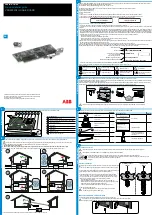
CHAPTER 3
Using terminal commands
33
the SDI-12 allowable characters 0..31, 127..255) are
substituted with an underscore (_). The arguments are the
same as in
sdi -
command.
•
sdi !
resets the SDI-12 configuration. All previous entries are
deleted from the configuration table.
•
sdi *
forces a sensor discovery cycle after the next
measurement cycle. The status of the operation can be
checked by issuing an sdi command without arguments (the
GET version). All sensors discovered will be displayed in the
list. When the discovery operation ends, “D” flag changes
back to “d” (see also below).
CAUTION
Use the
sdi !
and
sdi *
command with absolute
precaution, because the RTU’s SDI-12 configuration may be
deleted!
R
ETURNS
The following information is supplied in the form of a string of
characters in the case the command was issued without arguments
(the GET variant):
•
a/A
—
The presence of the SDI-12 BUS:
a
absent,
A
active;
•
w/W
—
Wait-State of the system:
w
not waiting,
W
waiting for
an SDI-12 sensor;
•
m/M
—
Measurement command status:
m
no measurement is
being done,
M
a measurement is in progress;
•
v/V
—
Availability of Values for storage:
v
no values are
available,
V
values are available for local storage;
•
d/D
—
discovery initiation:
d
no discovery pending,
D
discovery pending (will be done at the next sensor poll cycle).
In addition, for every programmed SDI-12 sensor, the following
information will be listed:
•
sensor id
—
the sensor ID in ASCII (0 - 9, A - Z and a - z);
•
CRC
—
the measuring method, either
M
(normal)
or
R
(continuous), optionally followed by the CRC flag (C);
•
index
—
the indices used (in hexadecimal), e.g.:
0x3
if indices
0 and 1 are used.
Note: For further information about the significance of the above
terms please also consult the specification of the SDI-12
standard, version 1.3 (http://www.sdi-12.org).









































